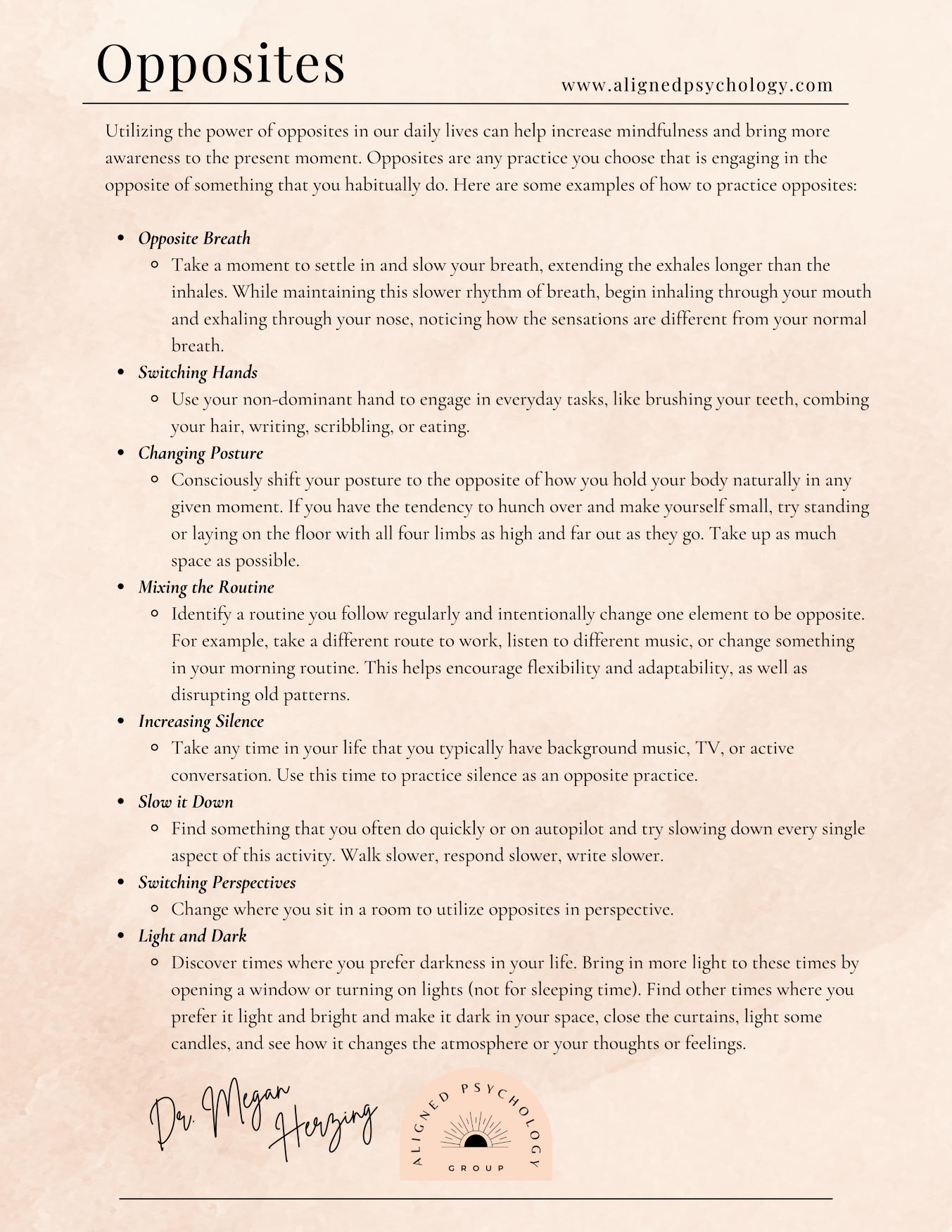Trauma Therapy Homework - Week 4
Week 4: (The Basics)
The Power of Opposites
Mindfulness is a cornerstone of trauma therapy, offering a pathway to regulate the nervous system, ground the mind, and reconnect with the present moment. A unique and engaging way to deepen mindfulness is through the intentional use of opposites. Engaging with opposites—whether in movement, breath, or daily habits—can bring heightened awareness, foster neuroplasticity, and provide a sense of balance and control. This post explores how opposites can be incorporated into trauma therapy and mindfulness practices, with a focus on their role in regulating the nervous system.

Understanding Mindfulness and the Nervous System
Mindfulness is the practice of paying attention, on purpose, to the present moment without judgment. It invites us to notice sensations, thoughts, and emotions as they arise. For individuals navigating trauma, mindfulness serves as a bridge between the body and the mind, helping to regulate the autonomic nervous system (ANS).
The ANS consists of two primary branches: the sympathetic nervous system (SNS), which activates the body’s "fight or flight" response, and the parasympathetic nervous system (PNS), which governs "rest and digest" functions. Trauma often disrupts this balance, leading to hyperarousal or hypoarousal states. Mindfulness practices help recalibrate the ANS, promoting a sense of safety and stability.
Using Opposites to Cultivate Mindfulness
The concept of opposites invites us to engage with contrasts in our actions, thoughts, and sensations. This deliberate shift in perspective or behavior requires focused attention, anchoring us in the present moment. Let’s explore several practical ways to incorporate opposites into mindfulness practices.
Opposite Breath: Breathing Through the Mouth and Out the Nose
Breathing exercises are foundational in mindfulness and trauma therapy. Opposite breath, a practice of inhaling through the mouth and exhaling through the nose, offers a novel way to engage the breath and increase awareness.
How to Practice Opposite Breath:
- Find a comfortable seated or lying position.
- Take a slow, deep breath in through your mouth, allowing your chest and belly to expand.
- Exhale gently through your nose, noticing the sensation of air passing through the nostrils.
- Repeat this cycle for several minutes, maintaining a steady and relaxed rhythm.
Benefits of Opposite Breath:
- Enhances focus by requiring intentional engagement.
- Activates the parasympathetic nervous system, promoting relaxation.
- Offers a sensory contrast that grounds the mind in the present moment.


Opposite Movements: Switching Hands for Daily Tasks
Another way to incorporate opposites into mindfulness is by using the non-dominant hand for routine activities such as brushing your teeth, combing your hair, or eating.
How to Practice Opposite Movements:
Identify a daily task you typically perform with your dominant hand.
Consciously switch to your non-dominant hand.
Notice the sensations, thoughts, and challenges that arise as you complete the task.
Benefits of Opposite Movements:
Engages different neural pathways, fostering neuroplasticity.
Increases awareness of habitual patterns and unconscious movements.
Provides an opportunity to approach routine tasks with curiosity and openness.


Opposite Postures: Changing Body Position
Exploring opposites in body posture can also enhance mindfulness. For example, if you tend to slouch, practice sitting upright with a tall spine. If you’re accustomed to crossing your legs, try keeping both feet flat on the ground.
How to Practice Opposite Postures:
- Notice your habitual posture in a given moment.
- Consciously shift to the opposite posture.
- Pay attention to the physical sensations and emotional responses that accompany the change.
Benefits of Opposite Postures:
- Increases body awareness and connection.
- Encourages exploration of comfort and discomfort.
- Promotes alignment and balance in the body.
Opposite Routines: Breaking Habits
Breaking habitual routines by doing the opposite can disrupt autopilot behavior and bring mindfulness into daily life. For instance, take a different route to work or change the order of your morning routine.
How to Practice Opposite Routines:
Identify a routine you follow regularly.
Intentionally change one element of the routine.
Observe how the change impacts your experience.
Benefits of Opposite Routines:
Encourages flexibility and adaptability.
Heightens awareness of surroundings and choices.
Reduces reliance on habitual patterns, fostering presence.
Tips for Incorporating Opposites into Your Mindfulness Practice
Start Small: Begin with one or two opposite practices that feel manageable and build from there.
Set Intentions: Approach each practice with curiosity and a willingness to explore.
Reflect on Your Experience: Take time to journal or mentally note how engaging with opposites impacts your thoughts, emotions, and body.
Be Patient: Adjusting to new practices can take time. Celebrate small moments of awareness and growth.

Conclusion
The intentional use of opposites offers a creative and accessible way to deepen mindfulness and regulate the nervous system. Whether through opposite breath, movements, postures, or routines, these practices invite us to step out of autopilot and engage fully with the present moment. For those navigating trauma, this approach can be a powerful tool for fostering resilience, balance, and self-awareness. By embracing opposites, we open the door to new possibilities for healing and growth.
FREE Downloadable Handouts
Click this
LINK
for free access to downloadable PDFs from the Trauma Therapy Homework Series. You’ll be directed to my Google Drive folder, where you can explore all the handouts created so far. You can choose between a digital format for easy viewing on your device or a printable version if you prefer a hard copy.
Here is a preview of this week's handout! Click the link above to get your own free pdf copy.


ABOUT THE AUTHOR
Dr. Megan
Megan Herzing PsyD, Licensed Professional Clinical Counselor, specializes in trauma therapy and creating a safe, supportive space for healing. She integrates evidence-based modalities, including EMDR, Internal Family Systems (IFS), somatic therapy, and Emotionally Focused Therapy (EFT), to address the mind-body connection and empower clients on their journey to wellness. With extensive experience treating complex PTSD, anxiety, attachment injuries, and dissociation, she believes in the power of self-compassion and authentic connection to facilitate lasting change. Drawing from her own healing journey, she brings empathy and lived experience to her work, honoring each client’s unique path toward growth and resilience.
Thank you for being part of a community of humans that deeply cares about healing.
We are honored that you stopped by and hope our resources will continue to bring value to your life.
We are accepting new clients in California, and referrals are always appreciated.












